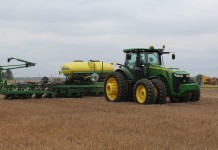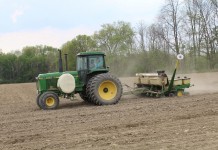URBANA, Ill. — Corn is responsible for most of the uncertainty in the market, and much of that is associated with the U.S. situation, said a University of Illinois Extension marketing specialist.
“Late corn planting suggests that planted acreage may not significantly exceed producer intentions of only 86 million acres,” said Darrel Good.
“Based on an analysis of trend yields since 1990, and adjusting for 2008 planting progress, the USDA forecast the 2008 yield at 153.9 bushels. That projection is above those based on a longer trend and appears a little optimistic.
Corn use
“Stocks of U.S. corn at the end of the 2008-2009 marketing year are projected at only 763 million bushels, or 6 percent of projected use. On the demand side, the biggest question may be about likely feed and residual use of corn.”
Use during the 2008-2009 marketing year is projected at 5.3 billion bushels, 850 million less than projected for the current year, but only 298 million less than used in 2006-2007.
“The wide swing in use the past two years means there is some uncertainty about the size of the feed demand base,” he said.
“How much reduction is really required and how much livestock liquidation has already started? Price behavior following the release of the USDA report suggests that the market believes that much of the needed rationing of use is already under way.”
World crop supply
Good’s comments came as he reviewed the May 9 releases of USDA updated projections for the 2007-2008 U.S. and world crop supply, consumption and price and made first projections for the 2008-2009 marketing year.
For soybeans, the USDA sees a sharp increase in the size of the U.S. crop in 2008, a continuation of very strong demand for U.S soybeans, a very modest build-up in U.S. inventories from the extremely low level expected this year and a continuation of high prices.
The average price received by U.S. producers for the 2008 crop is forecast in a range of $10.50 to $12, compared to $10 for the 2007 crop, said Good.
Supply and consumption forecast for 2008-2009 were not made for the rest of the world.
Expectations
For corn, the USDA expects a much smaller U.S. crop in 2008; a larger crop in other parts of the world; a substantial decline in U.S. exports and domestic feeding during the 2008-2009 marketing year; a large increase in domestic use of corn for ethanol production; a large decline in U.S. inventories; and a continuation of high prices.
The average price received by producers for the 2008 crop is forecast in a range of $5 to $6, compared to a range of $4.10 to $4.40 for the 2007 crop.
“Since it is still very early in the 2008-2009 growing season and since U.S. corn planting has been generally slow, a lot of uncertainty surrounds the USDA projections for the upcoming marketing year,” said Good.
This uncertainty is revealed in the futures market where prices for the 2008 crops of wheat, soybeans and corn all exceed the price implied by the upper end of the average farm price projected by the USDA.
Projections
Most of the uncertainty lies on the supply side of the projections, Good said, but there are also numerous issues surrounding demand prospects.
For wheat, much of the projection uncertainty involves the Australian crop, which is currently being planted. Following two years of drought and small crops, expectations are for a significant rebound in Australian production and a doubling of exports.
Dry weather, however, is still of some concern in eastern production regions. Large increases in production are also expected in Europe and the Ukraine, where weather issues are minimal at this time.
Soybeans
In the case of soybeans, U.S. production prospects are clouded by both acreage and yield uncertainty. Continued delays in planting corn could add to the already large increase planned for soybean acreage, while delayed planting of soybeans might also lead to concerns about 2008 yield prospects.
Based on an analysis of regional trend yields since 1989, the USDA projects an average U.S. yield of 42.1 bushels in 2008. That is 0.9 bushels above the 2007 average and 0.9 bushels below the record yield of 2005.
Exports of U.S. soybeans are expected to remain large in 2008-2009, presumably due to a continuation of strong demand from China.
“The size of the 2009 South American crop will have some influence on demand for U.S. soybeans as well,” said Good.
The domestic crush of soybeans is expected to increase to a new record level in 2008-2009, driven by increasing domestic use of soybean meal.
“The projected increase in domestic meal use is in contrast to the decline projected for grain feeding and is very dependent on the rate of expansion in broiler production — projected at 0.8 percent in 2009 — and the rate of decline in pork production — projected at 2.4 percent in 2009.”












